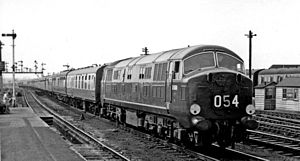British Rail Class 41 (Warship Class)
| British Rail Class 41 | |||||||||||||||||||||||||||||||||||||
|---|---|---|---|---|---|---|---|---|---|---|---|---|---|---|---|---|---|---|---|---|---|---|---|---|---|---|---|---|---|---|---|---|---|---|---|---|---|

D600 'Active' at Reading in 1959
|
|||||||||||||||||||||||||||||||||||||
|
|||||||||||||||||||||||||||||||||||||
|
|||||||||||||||||||||||||||||||||||||
|
|||||||||||||||||||||||||||||||||||||
|
|||||||||||||||||||||||||||||||||||||
| Type and origin | |
|---|---|
| Power type | Diesel-hydraulic |
| Builder | North British Locomotive Co. |
| Serial number | 27660–27664 |
| Build date | 1958–1959 |
| Total produced | 5 |
| Specifications | |
|---|---|
| Configuration: |
|
| • UIC | (A1A)(A1A) |
| • Commonwealth | A1A-A1A |
| Gauge | 4 ft 8 1⁄2 in (1,435 mm) standard gauge |
| Wheel diameter |
Driving: 3 ft 7 in (1.092 m) Idling: 3 ft 3 1⁄2 in (1.003 m) |
| Wheelbase | 50 ft 0 in (15.24 m) |
| Length | 65 ft 0 in (19.81 m) |
| Width | 8 ft 8 in (2.64 m) |
| Height | 12 ft 10 in (3.91 m) |
| Loco weight | 117 long tons (119 t; 131 short tons) |
| Fuel capacity | 800 imp gal (3,600 l; 960 US gal) |
| Prime mover | NBL-MAN L12V 18/21S, 2 off |
| Engine type | V12 Diesel |
| Transmission | Hydraulic, Voith L306r |
| MU working | ■ Orange Square |
| Train heating | Steam |
| Train brakes | Vacuum |
| Performance figures | |
|---|---|
| Maximum speed | 90 mph (145 km/h) |
| Power output | Engines: 1,000 bhp (746 kW) × 2 |
| Tractive effort |
Maximum: 50,000 lbf (222 kN) Continuous: 39,600 lbf (176 kN) |
| Brakeforce | 88 long tons-force (877 kN) |
| Career | |
|---|---|
| Operators | British Railways |
| Numbers | D600–D604 |
| Nicknames | "Warships” |
| Axle load class | Route availability |
| Retired | December 1967 |
| Disposition | All scrapped |
The British Railways Class 41 diesel-hydraulic locomotives were built by the North British Locomotive Company in Glasgow during 1957 and 1958. Although they were withdrawn before TOPS was introduced, British Rail classified them as Class 41. All were named after Royal Navy vessels, hence the nameplates each bore a subtitle "Warship Class".
The fleet was ordered by the British Transport Commission as direct comparison with British Rail Class 40, and were not actually wanted by the Western Region, who preferred their production fleet of D800 Warships. The D600s were the result of power politics within the BTC and the WR: the former was unwilling to sanction radical, stressed-skin lightweight construction locomotives at the time, while the latter was equally insistent that at least some of the new Type 4 power range locomotives on order be equipped with hydraulic transmission. They were much heavier than production Warships (almost 120 long tons (122 t; 134 short tons) compared to 80 long tons (81.3 t; 89.6 short tons)) and can be regarded as standard 1950s British design diesel locomotives that just happened to contain two lightweight, high-revving diesel engines coupled to hydraulic transmissions rather than one large, slow-revving diesel engine and electrical generator set. For this reason they were practically obsolete in design terms before they had left the drawing board.
Each locomotive was equipped with two MAN L12V18/21A diesel engines, each set to produce 1000 hp (750 kW) at 1445 rpm. This conservative rating was partly because NBL was very inexperienced at constructing diesel locomotives and partly because the Voith L306r three speed transmissions available at the time were not able to accept more. MAN had refined the engine design to produce 1,100 hp (820 kW) at around the time the D600 order was placed with NBL. The A1A-A1A wheel arrangement likewise came about because the BTC-mandated heavyweight construction required 6 axles to keep to a 20-ton axle loading, but NBL could not work out how to create a pivotless bogie and driving arrangement for C-C wheel arrangement. There were no C-C diesel-hydraulic locomotives to use as a template in mid-1955. The arrangement produced a continuous tractive effort of 39,600 lbf (176 kN) at 12.6 mph (20.3 km/h). Unusually for a British diesel locomotive, the D600s had spoked wheels. They could work in multiple with each other or up to two D6300 locomotives using the orange square coupling code.
...
Wikipedia
